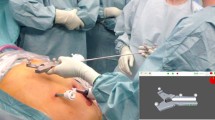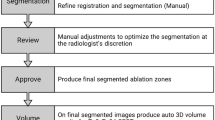Abstract
Objective
To evaluate and compare novel robotic guidance and manual approaches based on procedural accuracy, procedural time, procedural performance, image quality as well as patient dose during image-guided microwave thermoablation.
Method
The study was prospectively performed between June 2013 and December 2013 using 70 patients. Forty randomly selected patients (group 1) were treated with manual guidance and 30 patients (group 2) were treated using a novel robotic guidance. Parameters evaluated were procedural accuracy, total procedural time, procedural performance, quantitative/qualitative image quality and patient dose. Two-sided Student’s t test and Wilcoxon rank-sum test were used to test the significance of the data and p values less than 0.05 were considered statistically significant.
Result
Accuracy parameters were significantly higher in group 2 (all p < 0.05). Total procedural time showed a mean time difference of 3 min (group 2 > group 1; p = 0.0008). Volume CT dose index and dose–length product were significantly lower for group 2 compared to group 1 (all p < 0.05) for CT fluoroscopy imaging. Total procedural performance score was higher for group 2 compared to group 1 (p = 0.0001). Image quality parameters were insignificant between examined groups.
Conclusion
The novel robotic guided approach improved the accuracy of targeting the target tumour, reduced patient dose and increased procedural performance (which influences the procedural safety) during ablation.
Key Points
• Few reports are available in the literature regarding robotic-assisted liver microwave ablation.
• The robotic guided approach improved accuracy of localizing the target tumour.
• Radiation dose on patients was reduced with the robotic guidance.
• Numbers of insertions and readjustments were reduced, lowering chances of complications.




Similar content being viewed by others
References
Knavel EM, Brace CL (2013) Tumor ablation: common modalities and general practices. Tech Vasc Interv Radiol 16(4):192–200
Vogl TJ, Naguib NNN, Gruber-Rouh T, Koitka K, Lehnert T, Nour-Eldin NE (2011) Microwave ablation therapy: clinical utility in treatment of pulmonary metastases. Radiology 261:643–651
Ma X, Arellano RS, Gervais DA, Hahn PF, Mueller PR, Sahani DV (2010) Success of image-guided biopsy for small (<3 cm) focal liver lesions in cirrhotic and non-cirrhotic individuals. J Vasc Interv Radiol 21:1539–1547
Yu SC, Liew CT, Lau WY, Leung TW, Metreweli C (2001) US-guided percutaneous biopsy of small (<1-cm) hepatic lesions. Radiology 218:195–199
Nour-Eldin NE, Naguib NN, Mack M, Abskharon JE, Vogl TJ (2011) Pulmonary hemorrhage complicating radiofrequency ablation, from mild hemoptysis to life threatening pattern. Eur Radiol 21(1):197–204
Ding J, Jing X, Liu J et al (2013) Complications of thermal ablation of hepatic tumours: comparison of radiofrequency and microwave ablative techniques. Clin Radiol 68(6):608–615
Kloeckner R, dos Santos DP, Schneider J, Kara L, Dueber C, Pitton MB (2013) Radiation exposure in CT-guided interventions. Eur J Radiol 82(12):2253–2257
Kato R, Katada K, Anno H, Suzuki S, Ida Y, Koga S (1996) Radiation dosimetry at CT fluoroscopy: physician’s hand dose and development of needle holders. Radiology 201:576–578
Solomon SB, Patriciu A, Bohlman ME, Kavoussi LR, Stoianovici D (2002) Robotically driven interventions: a method of using CT fluoroscopy without radiation exposure to the physician. Radiology 225:277–282
Shin TY, Choi KH, Lim SK et al (2013) Simplified zero ischemia in robot assisted partial nephrectomy: initial yonsei experience. Kor J Urol 54:78–84
Paul J, Vogl TJ, Mbalisike EC (2012) Radiation dose and image quality evaluation relative to different contrast media using cone-beam CT. Imaging Med 4(5):505–513
Paul J, Bauer RW, Maentele W, Vogl TJ (2011) Image fusion in dual energy computed tomography for detection of various anatomic structures–effect on contrast enhancement, contrast-to-noise ratio, signal-to-noise ratio and image quality. Eur J Radiol 80(2):612–619
Paul J, Krauss B, Banckwitz R, Maentele W, Bauer RW, Vogl TJ (2012) Relationships of clinical protocols and reconstruction kernels with image quality and radiation dose in a 128-slice CT scanner: study with an anthropomorphic and water phantom. Eur J Radiol 81(5):e699–e703
Paul J, Jacobi V, Bazrafshan B, Farshid P, Vogl T (2013) Effect of contrast material on radiation dose in an adult cardiac dual-energy CT using retrospective ECG-gating. Health Phys 105(2):156–164
Koelblinger C, Schima W, Berger-Kulemann V et al (2013) C-arm CT during hepatic arteriography tumour-to-liver contrast: intraindividual comparison of three different contrast media application protocols. Eur Radiol 23:938–942
Goldberg SN, Grassi CJ, Cardella JF et al (2005) Image-guided tumor ablation: Standardization of terminology and reporting criteria. Radiology 235:728–739
Paul J, Schell B, Kerl JM, Maentele W, Vogl TJ, Bauer RW (2011) Effect of contrast material on image noise and radiation dose in adult chest computed tomography using automatic exposure control: a comparative study between 16-, 64-and 128-slice CT. Eur J Radiol 79(2):e128–e132
Paul J, Mbalisike EC, Nour-Eldin NE, Vogl TJ (2013) Dual-source 128-slice MDCT neck: radiation dose and image quality estimation of three different protocols. Eur J Radiol 82(5):787–796
Tam AL, Mohamed A, Pfister M et al (2010) C-arm cone beam computed tomography needle path overlay for fluoroscopic guided vertebroplasty. Spine 35:1095–1099
Schulz B, Eichler K, Siebenhandl P et al (2013) Accuracy and speed of robotic assisted needle interventions using a modern cone beam computed tomography intervention suite: a phantom study. Eur Radiol 23:198–204
Acknowledgments
We would like to thank Mrs. Neddermann and Mr. Ackermann of Johann Wolfgang Goethe University Frankfurt, Germany as well as Dr. Anjali of Perfint Healthcare for their relentless support and efforts during the time of this study. The authors would also like to acknowledge and thank Perfint Healthcare India for allowing the use of their MAXIO robotic system during the duration of the study. The scientific guarantor of this publication is Jijo Paul, Ph.D. The authors of this manuscript declare relationships with the following companies: Prakash Balakrishnan, M.Sc. is an employer of Perfint Healthcare Pvt. Ltd. The authors would like to thank Perfint Healthcare for loaning us their system for our study. The authors state that this work did not receive any funding. No complex statistical methods were necessary for this paper. Institutional review board approval was obtained. Written informed consent was waived by the institutional review board. The study has not been reported before anywhere. Methodology: prospective, performed at one institution.
Author information
Authors and Affiliations
Corresponding author
Rights and permissions
About this article
Cite this article
Mbalisike, E.C., Vogl, T.J., Zangos, S. et al. Image-guided microwave thermoablation of hepatic tumours using novel robotic guidance: an early experience. Eur Radiol 25, 454–462 (2015). https://doi.org/10.1007/s00330-014-3398-0
Received:
Revised:
Accepted:
Published:
Issue Date:
DOI: https://doi.org/10.1007/s00330-014-3398-0




